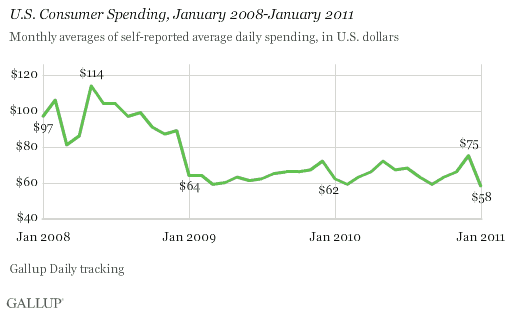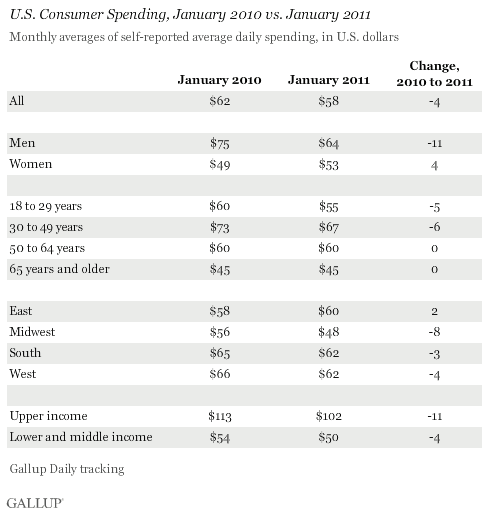PRINCETON, NJ -- Self-reported daily U.S. consumer spending in stores, restaurants, gas stations, and online averaged $58 per day in January 2011, down from the January averages of $62 in 2010 and $64 in 2009, and far below the $97 average of January 2008.

Gallup's spending data are not seasonally adjusted and essentially reflect discretionary consumer spending -- tracking closer to chain-store sales than to overall retail sales. During each month in 2010, Gallup's consumer spending measure remained relatively close to 2009 levels -- the "new normal trend." January 2011 spending results suggest the trends of the past two years may be continuing this year.
Women Spent More; Men, Less
Women spent an average of $53 per day in January -- up from $49 a year ago -- while men spent an average of $64, down from $75 in January 2010. However, a year-over-year comparison of spending behaviors across other demographic groups shows more modest differences. Those under 50 years of age spent less, while older Americans spent about the same amount as a year ago. Those in the East spent about the same as last year, while Americans in other regions spent less. Upper-income Americans as well as their lower- and middle-income counterparts spent less.

"New Normal" Spending Patterns Continue
Gallup data suggest Americans are as optimistic about the economy as they have been at any time during the past three years. And, Wall Street continues to "power" upward. Add in the late holiday splurge by upper-income consumers, and there seems to be good reason to hope for a significant increase in consumer spending in 2011.
On the other hand, Gallup's U.S. unemployment and underemployment measures have been increasing, and are in or near double digits. Oil, food, and other commodity prices have been surging.
A lack of job growth combined with higher food and gas prices may have convinced many Americans -- particularly lower- and middle-income consumers -- to continue holding back on their spending, as they have over the past couple of years. In this regard, the "new normal" spending patterns of 2009-2010 may be continuing unabated in 2011.
In absolute terms, January's $58 daily spending average is the lowest such average for a month since Gallup Daily tracking began in January 2008. Whether this new low in spending is an aberration resulting from the weather and/or the aftermath of a late holiday spending splurge -- with spending hitting its highest point in two years in December 2010 -- is not clear. Regardless, January's consumer spending remains close to the 2009-2010 "new normal" spending trend, and is nowhere near the $97 per day pre-"new normal" average of January 2008.
Gallup.com reports results from these indexes in daily, weekly, and monthly averages and in Gallup.com stories. Complete trend data are always available to view and export in the following charts:
Daily: Employment, Economic Confidence and Job Creation, Consumer Spending
Weekly: Employment, Economic Confidence, Job Creation, Consumer Spending
Read more about Gallup's economic measures.
View our economic release schedule.
Survey Methods
Results are based on telephone interviews conducted as part of Gallup Daily tracking during January 2011. Monthly results are based on telephone interviews conducted as part of Gallup Daily tracking with a random sample of approximately 14,000 adults, aged 18 and older, living in all 50 U.S. states and the District of Columbia, selected using random-digit-dial sampling.
For results based on the total monthly sample of national adults, one can say with 95% confidence that the maximum margin of sampling error is ±1 percentage point.
Interviews are conducted with respondents on landline telephones and cellular phones, with interviews conducted in Spanish for respondents who are primarily Spanish-speaking. Each daily sample includes a minimum quota of 200 cell phone respondents and 800 landline respondents, with additional minimum quotas among landline respondents for gender within region. Landline respondents are chosen at random within each household on the basis of which member had the most recent birthday.
Samples are weighted by gender, age, race, Hispanic ethnicity, education, region, adults in the household, cell phone-only status, cell phone-mostly status, and phone lines. Demographic weighting targets are based on the March 2010 Current Population Survey figures for the aged 18 and older non-institutionalized population living in U.S. telephone households. All reported margins of sampling error include the computed design effects for weighting and sample design.
In addition to sampling error, question wording and practical difficulties in conducting surveys can introduce error or bias into the findings of public opinion polls.
For more details on Gallup's polling methodology, visit www.gallup.com.
